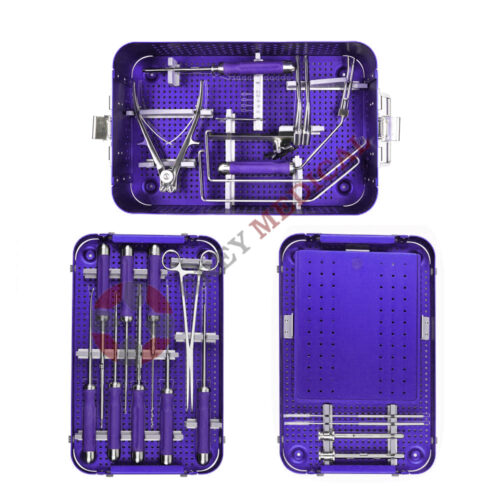Orthopaedic Surgical Instruments: Essential Tools for Bone and Joint Procedures
Explore the world of orthopedic precision at Grey-Medical, your trusted partner for high-quality Orthopedic Instruments Sets. We understand the pivotal role precision instruments play in orthopedic surgery, and our commitment to excellence shines in our carefully curated collection.
Orthopaedic surgical instruments are indispensable tools in the medical field, specifically designed for procedures involving the musculoskeletal system. These instruments are crafted to aid surgeons in treating injuries, deformities, and conditions related to bones, joints, ligaments, and tendons. With their specialized design and functionality, orthopaedic instruments ensure precise, efficient, and safe surgical outcomes.

Types of Orthopaedic Surgical Instruments
Orthopaedic surgical instruments come in various types, each tailored to a specific function during procedures. These instruments allow surgeons to perform tasks such as cutting, fixing, shaping, or manipulating bones and tissues with precision.
Cutting Instruments
Cutting instruments are used to excise or shape bones and tissues. Examples include bone saws for cutting through dense bone structures, osteotomes for splitting or sculpting bones, and rongeurs for removing small fragments of bone or soft tissues.
Fixation Instruments
Fixation instruments are critical for stabilizing bones and fractures. Tools such as bone plates, screws, and intramedullary nails provide support and secure alignment during healing, while external fixators are used to stabilize fractures externally.
Drilling and Pinning Instruments
Drilling instruments create precise holes in bones for implants or screws, while pins such as Kirschner wires (K-wires) provide temporary fixation. Countersinks are also used to prepare bone surfaces for screws to fit seamlessly.
Manipulation Instruments
Manipulation instruments assist in repositioning or aligning bones and joints. Bone holding clamps securely grip bones during surgery, while reduction forceps help align fractured bones for proper anatomical healing.
Retractors
Retractors hold tissues back to provide surgeons with an unobstructed view of the surgical site. Hohmann retractors and Volkmann retractors are common tools in orthopaedic surgeries for exposing bones and joints.
Joint Replacement Instruments
Specialized tools for joint replacement surgeries include acetabular reamers for shaping hip sockets, femoral impactors for placing hip implants, and ligament balancers for ensuring proper tension during knee replacements.
Applications of Orthopaedic Surgical Instruments
Orthopaedic instruments are used in a wide array of procedures aimed at restoring function and mobility. Their versatility makes them essential in addressing various musculoskeletal conditions.
Fracture Fixation
Instruments like bone plates and screws, external fixators, and intramedullary rods stabilize fractured bones, ensuring proper alignment and healing.
Joint Replacement Surgery
Joint replacement instruments facilitate procedures such as hip, knee, and shoulder replacements. These tools are designed to precisely place and secure prosthetic implants.
Arthroscopy
Arthroscopic instruments enable minimally invasive procedures to diagnose and treat joint issues, reducing recovery times and surgical trauma.
Spinal Surgery
Spinal instruments such as pedicle screws and retractors are essential for correcting spinal deformities, treating herniated discs, and performing spinal fusions.
Reconstructive and Sports Surgeries
Reconstructive surgeries often involve tools for reshaping or repairing bones, while sports injury treatments rely on instruments for ligament and tendon repairs.
Importance of Orthopaedic Instruments in Modern Healthcare
Orthopaedic surgical instruments are critical for ensuring precise and efficient procedures. Their specialized design allows surgeons to address complex cases, restore functionality, and improve patients' quality of life. As technology advances, these instruments continue to evolve, enhancing the capabilities of modern orthopaedic care.
Precision and Efficiency
High-quality orthopaedic instruments ensure accurate cuts, secure fixation, and precise manipulation, minimizing surgical complications and promoting faster recovery.
Specialized Design
Each instrument is designed to meet specific procedural needs, ensuring that surgeons can perform even the most complex surgeries with confidence.
Patient Outcomes
The use of well-designed orthopaedic instruments directly contributes to better surgical results, reduced recovery times, and improved overall patient care.
Conclusion
Orthopaedic surgical instruments play a vital role in treating musculoskeletal conditions, offering precision, reliability, and versatility. From fracture fixation to joint replacement, these tools empower surgeons to perform with accuracy and confidence. As advancements in technology and medical practices continue, orthopaedic instruments will remain indispensable in enhancing patient care and surgical outcomes.

 GreyMed
GreyMed